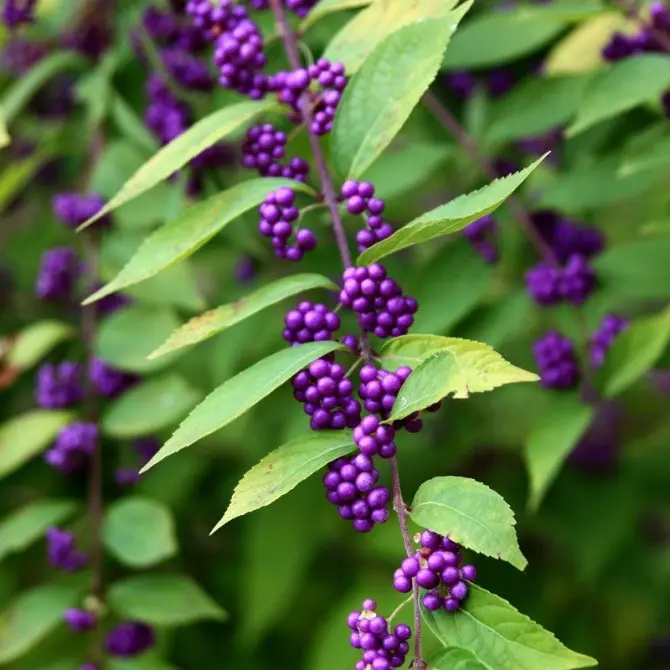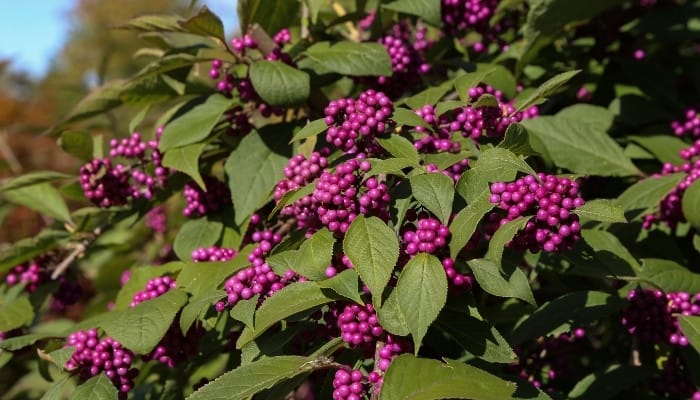The visually striking shrub known as the Purple Beautyberry or Callicarpa americana is a native of the Southern United States and has the added advantage of bearing edible berries. These small, purple fruits, which are popular among wildlife, are also safe for human consumption and can be used to create a variety of beautyberry recipes, such as jelly and juice. (Source: USDA Plants Database)
Are beautyberries edible? Yes, purple beautyberries are safe for human consumption in small quantities and are used in making jams, jellies, and juices. The flavor of beautyberry is unique, adding a special touch to these culinary creations.
Despite their astringent taste, raw beautyberries are nutritionally beneficial and versatile in cooking. They are worth foraging for. Beyond their culinary uses, these berries and their leaves, known for their effective mosquito repellent properties, contribute to the beautyberry’s allure. (Source)
Key Takeaways: Edible Beautyberry
- Who Eats Them & How They Taste: Beautyberries are enjoyed by both wildlife and humans. Their taste is somewhat sweet with a hint of spicy, reminiscent of Asian five-spice. While not commonly found in grocery stores, they offer a unique flavor profile for adventurous palates.
- Best Way to Eat: The most popular way to consume beautyberries is by making jelly, due to their unique flavor. Other enjoyable forms include eating them raw (in small amounts), as part of pies, or brewed into beautyberries tea.
- Common Uses: Beyond eating, beautyberries have ornamental value in gardens, serve as a natural mosquito repellent due to the compound in their leaves, and have traditional medicinal uses, though not scientifically validated. They are also a crucial food source for birds and wildlife.

How to Eat Beautyberries?
The Purple Beautyberry, a common sight in many yards, is not only a decorative shrub but also a source of edible berries. Despite their slightly astringent taste, these berries can be transformed into delightful culinary creations. Rich in a chemical compound called callicarpenal, which is known for its mosquito-repellent properties, the beautyberry offers both practicality and flavor.
Below, we cover all you need to know about eating these American berries.
Identifying American Beautyberries?
The American beautyberry plant features a rough-skinned stem, large oval, toothed leaves that are yellowish-green to deep-green, and small, light purple flowers. Most of these beautyberry plants grow to a height and width of 3-5 feet. The distinctive bright purple berries, known for their nutritional value and medicinal uses, ripen in clusters and are a popular choice for various beautyberry recipes and tea.
To identify these edible beautyberries look for their unique leaf shape, flower color, and unmistakable clusters of bright purple berries.Oklahoma State University
How to Harvest Beautyberry Plants?
American beautyberries that are ripe appear as half a dozen or more clusters consisting of vivid purple berry clusters on each stem of the plant. Harvesting Beautyberry Plants can be a rewarding experience.
Here is a simple guide:
- Timing: Harvest when the berries turn vibrant purple, typically in late summer or early fall, after the American beautyberry flowers have bloomed.
- Method: Gently pick the berry clusters from the bush; this is the easiest way to ensure the berries don’t get crushed.
- Be Aware: Inspect for pests or damage, and consider leaving some berries on the plant to support healthy growing and natural genus propagation.
- Seed Collection: For those interested in propagation, collect beautyberry seeds from ripe berries.
- Use: Utilize freshly harvested berries promptly in various recipes or store them properly for later use.
How To Pick Beautyberries
Picking beautyberries is like picking blackberries or raspberries. Take a bowl or basket and hand-pick the berries from the stems, cluster by cluster.
Place them gently into the bowl, and store them in a cool, dry place (or the fridge).
Most Popular Way to Eat Beautyberries
Beautyberries may not be as well known or widely available as other types of berries, but there are just as many ways to eat the American beautyberry.
You can eat beautyberries:
- Raw (in small amounts only)
- Dried
- In pie
- As jelly
- As jam
- As sauce
- In tea
Beautyberry Recipes
Here are three simple Beautyberry recipes:
- Beautyberry Jelly:
- Ingredients: 4 cups beautyberry juice, 5 cups sugar, 1 package of pectin.
- Method: Boil the berries and strain to get the juice. Mix juice with pectin, bring to a rolling boil. Add sugar, boil for 2 minutes. Pour into sterilized jars and seal.
- Uses: A top choice for a unique spread on toast or pastries.
- Beautyberry Tea:
- Ingredients: 1 cup fresh beautyberries, water.
- Method: Crush the berries, add to boiling water. Steep for 10 minutes, strain, and serve.
- Benefits: This tea might offer relief from minor aches and is believed by some to treat malarial fevers and rheumatism.
- Beautyberry Syrup:
- Ingredients: 2 cups beautyberries, 1 cup water, 1 cup sugar.
- Method: Boil the berries and water, mash and strain the mixture. Return the liquid to the pot, add sugar, and simmer until thick.
- Variety: Use this syrup in cocktails or as a drizzle on desserts.
Note: Beautyberry recipes often utilize purple berries, whereas the yellow variant is less common but can also be used. While these recipes are simple, you might find that the unique flavor of beautyberries enhances many dishes. In regions like South Florida, where these shrubs are abundant, these recipes are particularly popular.
Other Uses and Benefits of American Beautyberries
The American Beautyberry’s combination of ornamental beauty, potential medicinal uses, and nutritional value, along with its practical benefits, make it a diverse and valuable addition to any landscape.
Beautyberry Medicinal Uses
Traditionally, beautyberry has been used for its potential to treat minor ailments and skin irritations. Some cultures have also used it to treat malarial fevers and rheumatism, although these uses have not been scientifically validated.
Nutritional Benefits: Beautyberries, high in antioxidants and vitamins, support a healthy diet and immune function. For nutrition benefits and uses of other berries, we recommend reading ‘Huckleberry vs. Elderberry: Plant ID, Taste, Benefits & Uses‘
Beautyberry Plants – Mosquito Repellent
The leaves contain a compound that can kill mosquitoes and act as a natural insect repellent, making it a practical addition to outdoor spaces.
If you are interested in natural mosquito killers, you should read our article on Lemongrass.
Ornamental Use of American Beautyberries
Its striking purple berries and lush foliage make it a perfect choice for adding aesthetic appeal to gardens. The berries provide a vital food source for birds and other wildlife, enhancing the ecological value of your garden.
Caution with Poison: While the berries are safe for human consumption, it’s crucial to avoid confusion with other potentially poisonous berries and ensure proper identification before eating.
Frequently Asked Questions (FAQ):
Are Beautyberries Edible and Could They Be Poisonous?
They are safe for human consumption in small quantities, and commonly used in making jams, jellies, and teas. However, it’s important to correctly identify them, as there are other berries that are toxic.
What Do Beauty Berries Taste Like?
Beautyberries taste slightly sweet with a spicy touch. If you know the Asian five-spice, the flavor is similar.
Beautyberries are a curiosity to even those fonder of berries than most, simply because they are a rarity. You’ll never find them at the grocery store.
Are Beautyberries Leafs Edible?
Beautyberry leaves are not typically consumed by humans. Although not toxic, they are mainly used as mosquito repellent, not food.
What’s the Difference Between Beautyberry and Poke Berry?
Purple beautyberry is a wild berry that is highly edible for both humans and animals. Poke berry, on the other hand, is a much darker-colored berry that is poisonous. In fact, the entire plant is poisonous.
Ingesting these purple-black berries or even a sliver of its traffic-cone-sized root may cause hallucinations.
Visually, beautyberry is lighter and in clusters, while pokeberry stems are reddish-purple.

